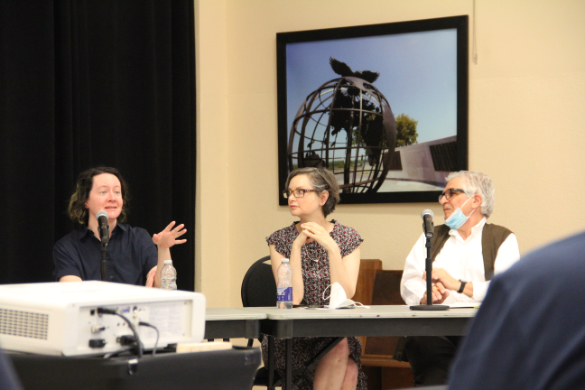Student Blog: Making Visible Minority Experiences

We are continuing our series of student blogs with a number of reflections on the “Small Modernisms” symposium, a public event held at the Carleton Dominion-Chalmers Centre on May 12-13, 2022. The event was organized by Professors Michael Windover and Dustin Valen. The blogs were written by undergraduate students in the History and Theory of Architecture and Art History programs in Carleton’s School for Studies in Art and Culture.
By Mayesha Alam
“Small Modernisms” highlighted how architectural historians can explore social issues through their work. Some of the most influential topics discussed at the symposium were how protest movements made use of the built environment and the experience of visible minorities in postwar cities. Social issues, such as racial discrimination and gentrification, are rarely discussed in architectural histories of the postwar, even though they are recognized as important issues today. The symposium changed that by highlighting current social issues in relation to building culture during this period.
One topic that struck me was how immigrants to Canada adapted to life in a new country. Presenter Cynthia Hammond explored this topic in her paper “La Ville extraordinaire: Memories of Urban Change and Diversity in Montreal.” Her paper considered the narratives of immigrant families in multicultural Montreal, and their forced relocation at the hands of public and private developers. These stories resonated with me since my own parents immigrated to Canada in search of a better life for their family. Indeed, the history of immigration is a patchwork of similar stories. Listening to Hammond’s presentation, I heard stories of Montreal’s Chinatown reconstructed through oral history. By conducting interviews with former residents, she showed how people adapted to life in Canada and created new identities, despite the government’s and private developer’s efforts to gentrify their neighbourhood. The memories surrounding these events are as much a part of the community now, and many people still consider Montreal’s Chinatown to be their home.
Sara Steven’s paper on “Vancouver’s Urban Renewal: Four Schemes, One Site” explored similar issues. Her presentation highlighted how modernist architects and planners attempted to “improve” a traditionally working-class neighborhood near Vancouver’s Chinatown by redeveloping the site. It was interesting to see the different sketches and concept drawings, and how architects presented their vision for a modern Vancouver. The final scheme was a cooperative housing development, known as Mau Dan Gardens, whose architect took into account local residents’ wishes and needs. Community participation was also key to designing the new neighbourhood, making it an ethical rehabilitation. The neighbourhood incorporates traditional Chinese design features (like courtyards) and reflects the activities and cultural identities of Chinese-Canadians.
This symposium brought forth many local stories in Canada during the postwar. For me, however, the most interesting stories were those about immigration and the struggles of ethnic minorities. Canada’s diverse multiculturalism is the result of people coming here from different parts of the world, bringing their stories and cultures with them. Relocating to a new country and starting a new life can be a daunting task. Architecture plays a pivotal role in this transition by allowing people who share similar cultural backgrounds and values to come together and create a new community.